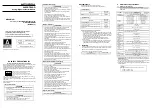
26
fore performing any inspection, maintenance,
or cleaning procedures.
1. Before each use, inspect the general condi-
tion of the Welder. Check for loose cable con-
nections, misalignment or binding of the fan,
cracked or broken parts, damaged electrical
wiring, and any other condition that may af-
fect its safe operation. If abnormal noise or
vibration occurs, have the problem corrected
before further use. Do not use damaged equip-
ment.
2. Periodically recheck all nuts, bolts, and
screws for tightness.
3. Periodically blow the dust from the cooling
vents with compressed air.
4. Verify that the cooling fan is operational
before welding.
5. If the unit repeatedly shuts down from ther-
mal overload, stop all use. Have the welder
inspected and repaired by a qualified service
technician.
6. Store the welder and accessories in a clean
and dry location.
7. Periodically disassemble and clean the Torch
Head components with steel wool. Replace
burnt, cracked, distorted, or coated compo-
nents, Refer to the assembly drawing.
8. To gain access to the internal components
of the unit, remove screws from Main Body
Cover. The home user is strongly advised not to
remove the tool covers and not to attempt any
electronic repairs. Any repairs must be com-
pleted by a qualified technician. Opening the
tool will void any warranties, and may result
in damage to equipment or possible personal
injury. Don’t do it.
9. On a daily basis check for any of the follow-
ing problems: If any are found, take the tool to
a qualified repair technician.
a. Abnormal vibration, sound or smell.
b. Abnormal heating at any cable connection.
c. Then fan does not work properly.
d. Any switch or control does not work prop-
erly.
e. Any damage to cables.
TROUBLESHOOTING
Be CERTAIN to shut off the TIG Welder, and
disconnect it from power and air before ad-
justing, cleaning, or repairing the unit. A tech-
nician should discharge all capacitors before
performing and internal procedures.
WIRE FEED MOTOR RUNS BUT WIRE DOES
NOT FEED PROPERLY
Insufficient wire feed pressure: Increase wire
feed pressure properly.
Incorrect wire feed roll size: Replace with the
proper one - follow the wire spool instructions.
Damaged torch, cable, or liner assembly: Have
a qualified technician inspect these parts and
replace as necessary.
WIRE CREATES A BIRDS NEST DURING OP-
ERATION
Excess wire feed pressure: Adjust wire feed
pressure properly.
Incorrect contact tip size: Replace with the
proper tip for the wire size used.
Gun end not inserted into drive housing prop-
erly: Loosen gun securing bolt and push gun
end into housing just enough so that it does
not touch wire feed mechanism.
Damaged liner: Have a qualified technician
inspect and repair/replace as necessary
ARC NOT STABLE
Wire not feeding properly: See first trouble-
shooting section above.
Incorrect contact tip size: Replace with the
proper tip for the wire size used.
Incorrect wire feed speed: Adjust wire feed
speed to achieve a more stable arc.
Loose torch cable or ground cable: Check to
ensure that all connections are tight.
Damaged torch or loose connection within
torch: Have a qualified technician inspect and
repair/replace as necessary.
WELDER DOES NOT FUNCTION WHEN
SWITCHED ON
Tripped thermal protection device: Shut the
welder’s switch to off and allow it to cool for at
least 20 minutes. Reduce duration or frequency
of welding periods to help reduce wear on the
welder. Refer to Duty Cycle section.
Faulty or improperly connected control Switch:
Have a technician check and secure/replace
Control Switch.
Internal fuse blown: Have a qualified techni-
cian check/replace.
SOLM1020 manual.indd 26
26/11/15 2:53 p.m.



































